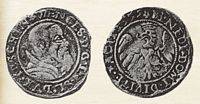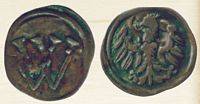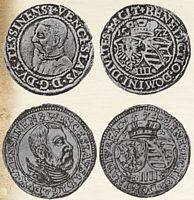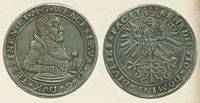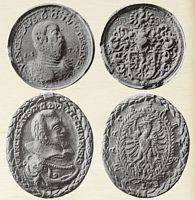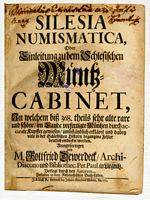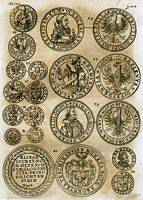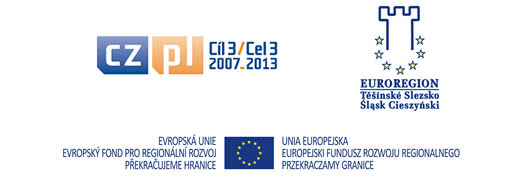The times of Prince Wenceslas Adam (1528 - 1579)
Prince Wenceslas Adam, the grandson and successor of Casimir II, took over as an independent ruler around 1545. However, it took over ten years before the Cieszyn mint began working again, since in the first part of his rule the Prince was mainly occupied with introducing the Reformation to the Cieszyn Duchy. The Cieszyn mint only started functioning again in 1559, although according to the common practice of the time the Prince leased the right to mint to a mint master for a fee. Hans Enders (or Endres) became the first mint master to come into conflict with town authorities at the beginning. The conflict was described in a letter of 1560 from the Prince to the Cieszyn town authorities. It stated that Enders had arranged to be supplied with 400 grzywna of silver for coining but the town council would not agree to grant the mint master permission without him signing a guarantee against potential fire damage. Since the mint master had already complied with all the safety regulations, the Prince ordered the council’s members not to disturb either the mint master or his assistants at work. Enders’ coins were struck with his mark; a heart pierced by a spear with a pennant. Most of the coins of various denominations dating from his times have survived; from small hellers to 3 groschen coins (weighing 2.57 g). In Poland, where they were called trojaki, 3 groschen coins were put into circulation by King Sigismund the Old in the first half of the 16th century.
The first period of the Cieszyn mint’s operation during the rule of Prince Wenceslas lasted from 1559 to 1562. During that time Enders issued two variants of 3 groschen coins (both in 1559) and three emissions of groschens. The obverse of the 3 groschen coin bears a portrait of the mature, bearded Prince wearing a fashionable standing collar. On the reverse instead of the eagle there is an inscription reading BENEDICTIO DOMINI DIVITES FACIT (The Lord's blessing gives wealth) which actually appears on all the coins dating from the first period of Prince Wenceslas’ minting. The same motifs – the Prince’s bust and the inscription mentioned above – appear on groschens of one of the emissions of 1559. However, groschens issued in 1559, 1560 and 1561 seem to be more intriguing; according to the Prince’s will they bear a likeness of St. Nicholas, the bishop of Bari. On the obverse is an elegant late Renaissance crowned eagle, the legend within the border reading WENCESL.D.G.DVX.TESINE and a date. On the reverse is a three-quarter figure of St. Nicholas wearing his pontificals. His left hand holds a pectoral cross while the right one holds a cushion with three balls resting on it. Some emissions of this groschen even contain an in-scription reading S.NICOLAV.EPISCOPVS. Within the border is the same legend as mentioned above, Prince Wenceslas’ favourite motto, which is a quotation from the Book of Proverbs (10:22). It is known that Bishop Nicholas’s ministry was not only restricted to giving children gifts. The three balls depicted on the coin refer to three gold nuggets which according to the most popular legend the saint gave his neighbour in secret in order to enable his three daughters to marry. Prince Wenceslas was a Protestant ruler. It was him who established Lutheranism as the dominant religion in the Duchy of Cieszyn, therefore the reference to the Bible is understandable. Yet the image of the Catholic saint on the Protestant church is indeed remarkable. St. Nicholas was the patron saint of the castle chapel, the oldest church in the Cieszyn Duchy, and that gave rise to speculation that the coin was designed intentionally to depict the patron saint of the castle and not for instance that of the town. Nonetheless, it is more likely that the coins were supposed to resemble the coinage issued in German countries where busts of bishops were extremely common in the 16th century; for instance on the coins of the bishops of Salzburg and Würzburg.
Even a very humble undated heller from that period (hellers were then the smallest silver coinage circulating in Bohemian lands) was patterned on a foreign coin. It bears the crowned eagle and on the obverse – the letter W which is obviously the Prince’s monogram. Nevertheless the coin is still a stylised version of coins minted in Wrocław after the agreement of 1511 and bearing the monogram of the Bohemian King, Vladislas II the Jagiellonian. The heller was intended for circulation in Silesia and to resemble the better quality coinage common a few decades previously. For during the rule of Prince Wenceslas the work of Cieszyn mint masters was aimed to be exported beyond the duchy. The exportation of low-quality coin-age contributed to a rise in inflation in neighbouring countries, most often Poland. Although the mint master was respon-sible for this practice the Prince must have been aware of it.
In 1562 a new coin was issued. It weighed 0.6 g and was called a trojnik in Bohemian lands and a trzeciak in Poland since it was worth three hellers or 3/4 of a kreutzer. For at the same time in the mints of the Lands of the Crown of St. Wenceslas, e.g. in Wrocław, Ferdinand I had started minting kreutzers (or kreuzers), small silver coins which had been struck in Tyrol since the 13th century and which became some of the most common coinage in circulation in Central Europe. The Cieszyn 3 heller coin again bears a quotation from the Book of Proverbs on both sides, the obverse and the reverse, in the form of the partly abbreviated phrase BENEDITIO DO[MIN]I DIVI[TES] F[ACIT]. Moreover, on the obverse is the crowned Cieszyn eagle, while the reverse bears the letter T in a distinctive cartouche formed by a pattern of ten curved lines, clearly representing the name of the town and the duchy. This coin was intended for Poland since it resembles the 3 heller coins of Sigismund the Old dating from 1527-46. As far as the differences are concerned, the inscriptions are different and the Jagiellonian coat of arms, i.e. the double cross, is replaced in the cartouche by the T.
Minting in Cieszyn experienced a short hiatus after 1562 possibly due to the introduction by Emperor Ferdinand I of the so called guilder rate i.e. based on the guilder (Guldengroschen); equal in value to 60 kreutzers. The Cieszyn Prince restored minting in 1568, although the name of the mint master remains unknown. The mint restarted with a new issue of 3 heller coins – struck for the first time in 1562. It was coined again in 1569. In 1570 the Cieszyn mint struck a half groschen which bore the Cieszyn eagle on the reverse, with the Cieszyn Prince’s name and titles within the border, while the obverse bore a crown and the legend reading MAX.II.D.G.RO.IMP i.e. Maximilianus II, Dei Gratia Romanorum Imperator. This exceptional iconography of the Cieszyn coins dating from Prince Wenceslas’ times was meant to pay tribute to the liege-lord i.e. Bohemian King and Emperor Maximilian II Habsburg. It was an endeavour to convince him that the Cieszyn mint was not violating the Silesian mint ordinance in any way. In 1572 a kreutzer bearing the titles of Emperor Maximilian II was minted and then reissued several times in subsequent years. In 1574 a different type of kreutzer was struck. On the obverse there was the Cieszyn eagle and the legend within the border presenting the titles of Prince Wenceslas and his favourite motto, while the reverse bore the eagle on a shield.
In the 1570s higher denomination coins started being struck in the Cieszyn mint. The first of them was a 4 groschen coin (czworak) weighing 4.3 g and issued in 1572. Its obverse bears a bust of the Prince and his titles within the border, in Latin as usual. The reverse however, apart from the recognizable motto reading BENEDITIO DOMINI DIVITES FACIT, under the princely coronet bears the coats of arms of the Cieszyn Duchy and Saxony. The coin commemorated the second marriage of the Prince concluded in 1567 to Princess Catherine Sidonia, the daughter of Franz I, Duke of Sachsen-Lauenburg. A similar coin of the same denomination was struck in 1574. The difference concerns the Prince’s bust, this time with a much shorter beard and facing the other way. In the same year the most magnificent coin dating from the times of Prince Wenceslas Adam was issued; a silver thaler with a 42 mm diameter weighing 28.6 g. On the obverse is the armoured bust of the Prince with a chain on his chest. The legend within the border reads ENCESLAVS.D.G.DVX.TESSINEN.ET.M.G which stands for Wenceslaus, by the Grace of God, Prince of Cieszyn and Wielki Głogów. The reverse bears the proud crowned eagle and the broken legend within the border repeating the princely motto and also a date.
In 1568 Prince Wenceslas set up a mint in Skoczów. Small coins were struck there. They were hellers bearing the Cieszyn eagle on the obverse and the letter S on the dated reverse. The oldest son of Prince Wenceslas, Prince Frederick Casimir, following his father’s example minted coins in Bielsko. He was granted a sovereign dominion consisting of Fryątát and Frýdek in 1560. In 1565 his father added Bielsko and surrounding territories. Between 1568 and 1571 the mint in Bielsko issued kreutzers, 2 kreutzer coins and groschens. The obverse of higher denomination coins bears the bust of Frederick Casimir while the legends on the reverse differ; on kreutzers – SALUS NOSTRA, on 2 kreutzer coins – PRAESENTE DEO COMITE FORTVNA. Exceptional rarities are groschens struck in 1569 and 1570 with the legend on the obverse reading GROS.BILLICENSIS. Nevertheless even these efforts came to nothing, for the Prince lived beyond his means at his own court and on his death in 1571 left enormous debts. His father was forced to sell parts of the duchy to pay them off.
Frederick Casimir’s coins imitated those of Prince Wenceslas, most of which in turn resembled foreign coins, especially Polish ones. 3 groschen coins were patterned on the Gdańsk trojaki of Sigismund Augustus; groschens on Prussian groschens of Prince Albrecht Hohenzollern; and half groschens on half groschens of King Sigismund the Old. The hellers struck in Skoczów bore the letter S which might have been taken for the name Sigismundus. Poland was not at all pleased with these imitations nor was the Royal Breslau Chamber which put forward demands for the Prince to stop imitating foreign patterns and issue coins in accordance with local regulations i.e. Habsburg ones. Emperor Ferdinand I himself sent a letter to Wenceslas Adam in 1560 in which Ferdinand accused him of minting coins against regulations and imperial orders, and threatened him with severe sanctions. However, to no effect, for Wenceslas Adam thought of various explanations, e.g. replying straight out that the coinage was intended only for export to Poland. Emperor Maximilian II wrote to Prince Wenceslas in 1574 pointing out the damage to neighbouring Poland caused by his minting activity. The Emperor drew the Prince’s attention to the fact that he was not permitted to issue coins following any other rules and regulations apart from those binding in the Bohemian Kingdom which the Duchy of Cieszyn belonged to. But the Prince preferred to stop minting completely which finally came to pass in 1574. He died soon after.
Bearing in mind the close relationship between numismatics and medallic art it is worth mentioning two commemorative medals of Prince Wenceslas Adam. The first of them, a gold cast, dates from 1573. On its obverse is the bust of the Prince facing right, the date and the legend presenting the princely titles. The reverse bears a decorative cartouche with a shield with the Cieszyn Piasts’ crowned eagle. The second medal was issued two years later as an oval silver cast. The Prince’s bust and the titles are similar whereas the reverse bears the coat of arms and the motto ARTE ET MARTE which stands for By skill and by valour. What is more, drawings of some of Wenceslas Adam’s coins were featured in the classic work entitled Silesia numismatica, published in Jawor in 1711 and written by the pioneer of Silesian numismatics, the archdeacon and librarian from Legnica, Gotfryd Dewerdeck (died 1726).

